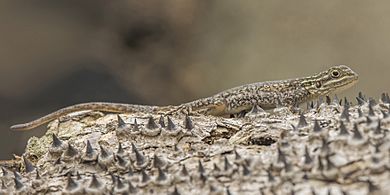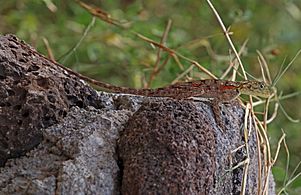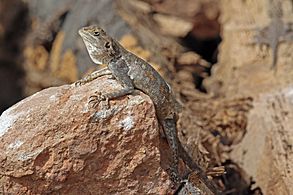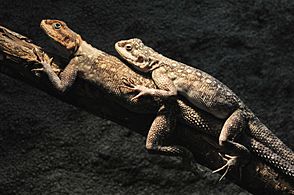Agama agama facts for kids
Quick facts for kids Agama agama |
|
|---|---|
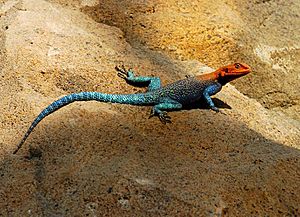 |
|
| Male | |
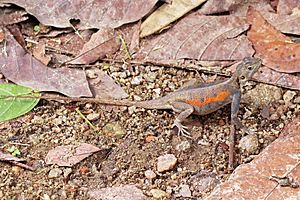 |
|
| Female both in Kakum National Park, Ghana |
|
| Conservation status | |
| Scientific classification | |
| Genus: |
Agama
|
| Species: |
agama
|
The common agama is a type of lizard found in many parts of sub-Saharan Africa. It is also known as the red-headed rock agama or rainbow agama. Its scientific name is Agama agama. These lizards belong to the Agamidae family. Scientists have studied them closely to understand the different types of agamas.
Contents
Description
These lizards can grow to be about 13 to 30 centimeters (5 to 12 inches) long. Male agamas are usually longer than females. They are typically 7.5 to 12 centimeters (3 to 5 inches) longer.
You can spot an agama lizard by its white belly and brown back legs. Its tail has a light stripe down the middle. This stripe often has about six or seven dark spots along its sides.
Young agamas, females, and males that are not in charge have an olive green head. But a dominant male, who leads the group, has a bright blue body and a yellow tail.
Where They Live and Their Home
The common agama lives naturally in many African countries. These include Benin, Burkina Faso, Uganda, Cameroon, Cape Verde, Chad, Gabon, Ghana, Guinea, Guinea-Bissau, Kenya, Liberia, Mali, Mauritania, Nigeria, Senegal, Togo, and Tanzania. They can also be found in India and Madagascar.
These lizards have also been brought to southern Florida in the United States. There, they have become very common. Common agamas are good at living in dry places. They stay active all day long. However, during the hottest part of the day, they will find shade. Even in the shade, it can be as hot as 38 degrees Celsius (100 degrees Fahrenheit).
What They Eat
Common agamas mainly eat insects. This means they are insectivores. They especially like ants, grasshoppers, beetles, and termites.
Sometimes, they also eat small mammals, other reptiles, and plants. These plants can include flowers, grasses, and fruits. They catch their food using their tongue. The tip of their tongue is sticky, which helps them hold onto smaller prey.
How They Behave
Male agamas are very protective of their space. They will fight other males to keep their territory. Agamas live in social groups. Each group has one main male, about six females, and some other males who are not in charge.
A male who is not in charge can only get his own group if he beats the main male. Or, he can start a new group in a place where no other main male has claimed territory. Only the main male is allowed to mate with the females in his group.
The center of a main male's territory is usually marked by something big. This could be a tree or a large rock. The lizards often gather around this spot. In cities, male agamas fight more often. This is because there is less space for them to claim.
How They Reproduce
Female agamas can start having babies when they are about 14 to 18 months old. Males are ready when they are 2 years old. Agama agama usually lays eggs during the wet season. However, they can also reproduce in places where it rains all the time.
When a female is ready, she digs a hole about 5 centimeters (2 inches) deep. She uses her snout and claws to dig in sandy, damp soil. This spot is usually covered with grass or other plants and gets sunlight most of the day.
After digging, the female lays 5 to 7 oval-shaped eggs. These eggs hatch in about 8 to 10 weeks. The temperature of the eggs affects if they will be male or female. Eggs kept at 29 degrees Celsius (84 degrees Fahrenheit) will become males. Eggs between 26 and 27 degrees Celsius (79 and 81 degrees Fahrenheit) will become females.
When they hatch, baby agamas are about 3.7 centimeters (1.5 inches) long from snout to vent. Their tail adds another 7.5 centimeters (3 inches) to their length.
-
juvenile, Ghana
-
juvenile, Ghana
-
male, Kenya
-
female, Kenya
-
female moulting, Gambia
-
Zoo Schmiding near Bad Schallerbach, Austria
See also
 In Spanish: Agama común para niños
In Spanish: Agama común para niños



